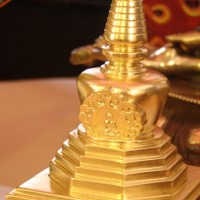
Shakyamuni, the historical Buddha, had instructed his disciples that after his passing, his body should be cremated and the remains enshrined in a reliquary monument, or stupa, as was the custom with regards to the great Indian leaders of the past.
His purpose for having such monuments erected was not self-aggrandizement but, in the words of the late Lama Govinda:
“To remind later generations of the great pioneers of humanity and inspire them to follow their example, to encourage them in their own struggle for liberation from suffering.”
A proper Buddhist altar holds the symbols of enlightened body, speech and mind, traditionally represented by displaying a statue or photo of Buddha Shakyamuni, a scripture, and a stupa.
The mind of the Buddha is traditionally represented by a stupa of enlightenment. The stupa should be placed to the right of the Buddha image, or below the Buddha if the altar consists of several levels.








